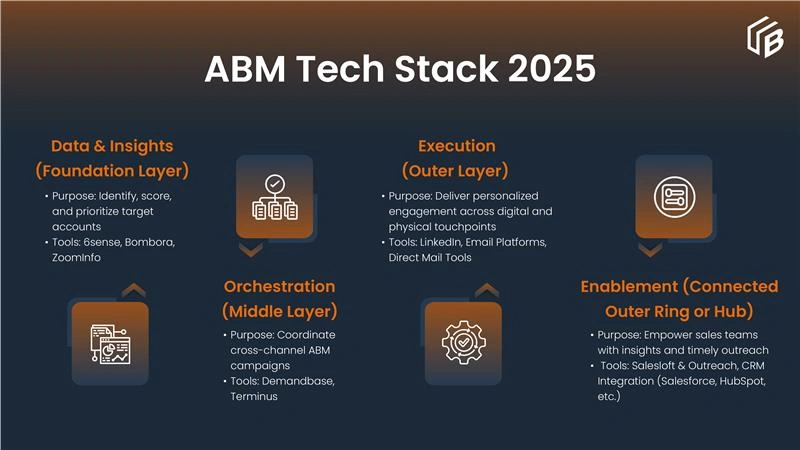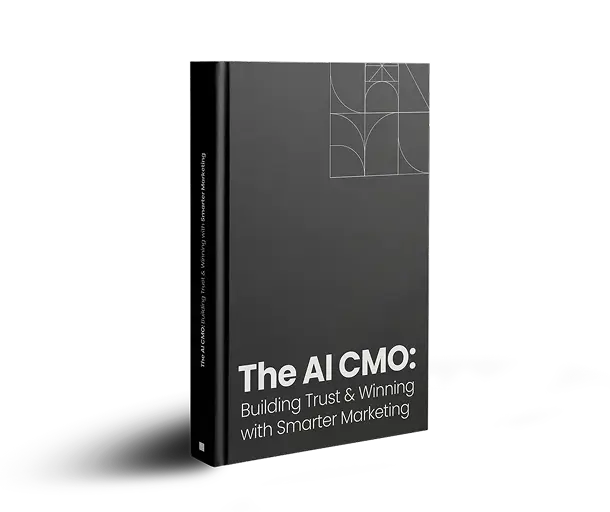
Introduction
Account-based marketing strategies are a competitive necessity, particularly in fast-moving sectors like SaaS and enterprise tech. As buying committees grow larger and sales cycles become more complex, the traditional marketing approach has given way to precision targeting and hyper-personalized outreach.
Modern ABM is built on the principle of treating individual accounts as markets of one. But what truly sets today’s ABM apart is the seamless integration of AI, real-time intent data, and predictive analytics. Marketers now have the power to not only identify high-value accounts but to understand their behavior, needs, and engage them with messages personalized to where they are in the buying journey.
This evolution has transformed ABM from a siloed marketing tactic into a company-wide growth engine by aligning marketing, sales, and revenue teams around a shared plan to win the accounts that matter most.
Strategy 1: Align Teams Around a Shared Account-Based Marketing Plan
In 2025, the foundation of any successful account-based marketing strategy is tight alignment between sales and marketing teams. Customer-obsessed companies that prioritize a seamless, personalized experience across sales and marketing seemed to grow revenue 28% faster, achieve 33% higher profitability, and enjoy 44% better customer retention compared to their less customer-focused counterparts.
At its core, alignment means working from a shared ABM plan, one that defines common goals, shared KPIs, and clear roles across the funnel. Marketing generates awareness and engagement through personalized content and campaigns, while sales drives direct conversations and conversions. But success depends on both sides collaborating from day one.
Key actions to foster alignment:
- Co-develop ICPs and target account lists
- Hold joint quarterly planning and weekly syncs
- Establish unified success metrics (like account engagement, pipeline velocity, and influenced revenue)
- Feed real-time feedback between teams via CRM and collaboration tools
When sales and marketing speak the same language and pursue the same accounts with coordinated tactics, ABM moves from theory to results consistently and at scale.
Strategy 2: Use Predictive and Intent Data to Prioritize High-Value Targets
Predictive analytics and intent data have become essential tools for B2B marketers aiming to identify high-value accounts ready to make a purchase. Platforms like 6sense and Bombora use AI and data aggregation to track buyer behavior, offering deep insights into which accounts are actively researching solutions. These insights enable marketers to prioritize accounts showing clear purchase intent, ensuring that resources are allocated efficiently.
Predictive analytics forecasts potential buyer behavior using historical data and machine learning, while intent data reveals when accounts are engaging with content related to your product or service. Integrating both into your ABM strategy allows for more accurate targeting and higher conversion rates.
Incorporating data insights allows companies to focus their efforts on the most promising accounts, increasing the chances of conversion and accelerating the sales cycle. Predictive and intent data are indispensable tools for refining ABM strategies and achieving better outcomes.

Strategy 3: Run Tiered ABM Programs (1:1, 1:Few, 1:Many) for Scale
A tiered approach to account-based marketing is one of the most effective ways to scale without sacrificing personalization. Marketing and sales teams can allocate resources based on account value and engagement potential by categorizing accounts into 1:1, 1:Few, and 1:Many tiers:
- 1:1 ABM is reserved for the highest-value accounts, where deep personalization (custom content, landing pages, executive outreach) can significantly increase win rates.
- 1:Few ABM targets small clusters of similar accounts with tailored messaging and semi-custom campaigns.
- 1:Many ABM leverages automation to personalize outreach at scale, ideal for broader segments with lower-touch strategies.
B2B companies with account-based marketing programs report a 38% higher sales win rate and 91% larger deal sizes, leading to 24% faster revenue growth.
The key to success? Start with strategic segmentation, match tactics to account value, and continuously optimize based on performance. When done right, a tiered ABM strategy delivers personalization where it matters most without overwhelming your team or budget.
Strategy 4: Orchestrate Multi-Channel Outreach Using Coordinated ABM Tactics
A multi-channel approach is essential for successful account-based marketing (ABM). Coordinating outreach across email, LinkedIn, webinars, direct mail, and paid media amplifies your message and increases touchpoints with target accounts. Research shows that multi-channel strategies boost engagement by 30% and increase customer retention by 15% compared to single-channel efforts.
Integration of ABM tech stack can streamline and synchronize campaigns across channels, ensuring consistent messaging. This orchestration maximizes engagement by delivering the right message at the right time, increasing both conversion rates and pipeline velocity.
In short, combining digital channels with personalized outreach through a cohesive ABM strategy will drive better results, keeping your brand front and center throughout the buying journey.
Strategy 5: Optimize LinkedIn for Account-Based Ads and Engagement
LinkedIn remains the most effective platform for executing B2B account-based marketing strategies, thanks to its rich data, professional context, and advanced targeting features. With over 1 billion members globally and more than 10 million C-suite executives on the platform, it offers unmatched access to key decision-makers in high-value accounts.
Matched Audiences allow marketers to upload target account lists and filter by job title, seniority, function, or even skills, enabling precise ad delivery to buying committee members. Marketers can then run sequential ad campaigns that guide prospects from awareness to conversion, adapting messaging at each stage of the buyer journey.
Recent benchmarks show that LinkedIn Sponsored Content delivers 2x higher engagement rates when used in ABM programs compared to traditional campaigns. Paired with Sales Navigator and CRM integrations, LinkedIn becomes not just a paid media channel, but a strategic ABM engine.
If you’re not using LinkedIn as a core part of your account based marketing plan, you’re leaving reach, influence, and pipeline on the table.
Strategy 6: Enable Sales with ABM Intelligence in Real-Time
The success of an account-based marketing strategy hinges on your ability to arm sales teams with real-time intelligence, not just static lead lists. SDRs and AEs now expect insights like web activity, content engagement, and intent signals directly inside their CRM to guide every interaction.
When sales knows exactly which accounts are showing buying signals, such as reading case studies, attending webinars, or comparing competitor solutions, they can reach out with relevance, not guesswork.
The key? Integration of tools which allows trigger-based outreach and smarter prioritization. As a result, reps spend less time on unqualified accounts and more time closing deals.
To fully enable your sales team:
- Feed ABM signals into your CRM and sales engagement platforms.
- Create alert systems for key activities (e.g., target account visits pricing page).
- Align RevOps teams to ensure clean handoffs and reporting.
The line between sales and marketing is blurred and that’s exactly how it should be. Real-time ABM intelligence makes that collaboration actionable.
Strategy 7: Partner with ABM Strategy Services to Accelerate Results
The complexity of executing high-performing account-based marketing campaigns has led many B2B organizations to seek external expertise. Collaborating with specialized ABM strategy services such as agencies, technology consultants, or go-to-market advisors, can significantly enhance the development and execution of ABM initiatives.
The Need for External ABM Expertise
Not every B2B marketing team possesses the bandwidth or specialized tools required to fully execute sophisticated ABM campaigns in-house. The challenges include:
- Resource Constraints: Limited internal resources can hinder the ability to develop and manage personalized campaigns at scale.
- Technological Complexity: Implementing and integrating advanced ABM technologies requires specialized knowledge and experience.
- Strategic Alignment: Ensuring cohesive strategies across marketing, sales, and customer success teams can be challenging without external guidance.
Engaging with ABM strategy services addresses these challenges by providing:
- Industry Expertise: Access to professionals with deep knowledge of ABM best practices and industry-specific insights.
- Integration Support: Assistance in seamlessly integrating ABM tools and platforms into existing systems.
- Analytics Capabilities: Advanced analytics to measure campaign performance and inform data-driven decisions.
Not every B2B marketing team has the bandwidth or tools to fully execute high-performing ABM campaigns in-house. That’s where ABM strategy services come in. Whether you’re looking to scale 1:1 engagement or build a full-funnel account based marketing plan, working with a specialized partner can accelerate results.
At UnboundB2B, we specialize in delivering customized account-based marketing services designed to meet the unique needs of B2B companies, particularly in the SaaS and enterprise sectors. Our offerings include:
- Targeted Account Identification: Utilizing data-driven methodologies to pinpoint high-value accounts that align with your business objectives.
- Multi-Channel Campaign Activation: Executing coordinated campaigns across various channels to maximize reach and engagement.
- Revenue Conversion Strategies: Implementing tactics that effectively convert account engagement into measurable revenue growth.
- ABM with an ABX Lens: We align not just your campaigns but your entire customer experience around high-value accounts. That includes pre-sale and post-sale experiences, powered by shared data between marketing, sales, and CX teams.
- Unbound Promote™– It combines account-based marketing with programmatic advertising to deliver hyper-targeted, scalable campaigns that engage high-value B2B accounts across digital channels.
Final Thoughts: Make ABM Your Strategic Growth Engine
Account-based marketing is a strategic discipline that top-performing B2B companies are using to drive consistent, scalable growth. As we move further into 2025, ABM is evolving fast, blending AI, intent data, and multi-channel orchestration into a unified approach that’s more precise, more measurable, and more aligned with how modern buying committees make decisions.
If you’re serious about accelerating pipeline and turning your highest-value targets into revenue, now’s the time to elevate your ABM playbook. And if you need a partner to help you execute with precision and scale, UnboundB2B is here to help.
Our blog
Latest blog posts
Tool and strategies modern teams need to help their companies grow.

Discover six hybrid B2B marketing event formats that drive real pipeline growth, enha...

Struggling to convert your SQLs? Learn the common mistake B2B companies make and opti...

Turn your owned channels into a precision account-based marketing (ABM) engine that w...






